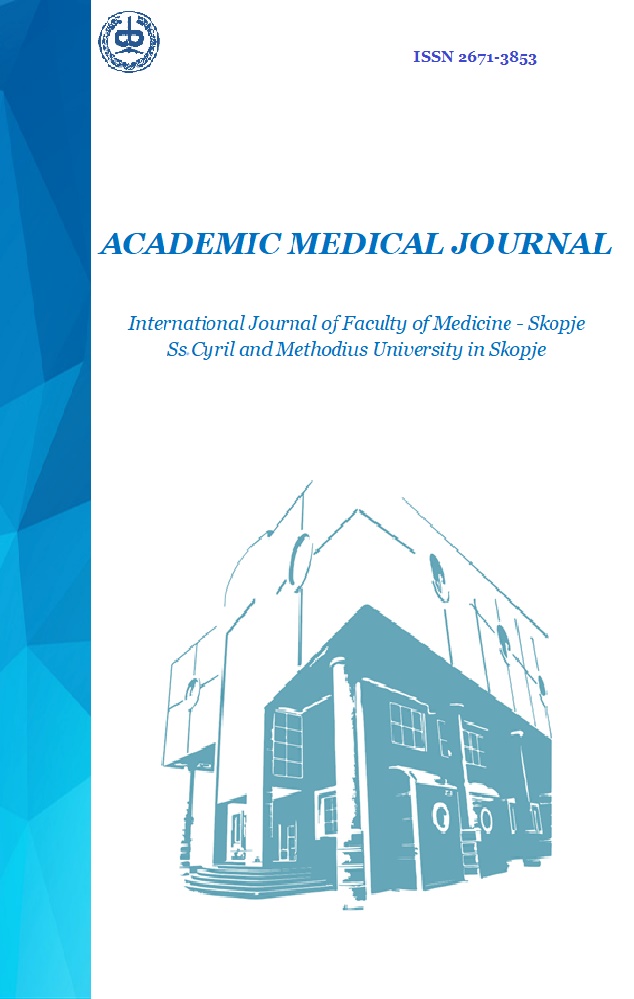DISTINCT SUBGROUP OF PATIENTS WITH UNMUTATED IGHV1-69 CHRONIC LYMPHOCYTIC LEUKEMIA AFFECTED WITH COVID‑19 INFECTION - SINGLE CENTER EXPERIENCE
Keywords:
Chronic lymphocytic leukemia, unmutated IGHV1-69, COVID-19, MortalityAbstract
Introduction: With the onset of infection with COVID-19, complications of this disease among vulnerable populations have been a primary alarm for health systems. Chronic lymphocytic leukemia (CLL) is characterized by variable clinical courses among patients with distinct genetic background, often leading to a compromised immune system, and, hence, these patients were seriously affected by this pandemic.
Aim of the study: Evaluation of COVID-19 infection outcome in a subgroup of patients with unmutated IGHV1-69 CLL.
Materials and methods: This was a retrospective study comprising 35 patients with CLL, diagnosed and followed in the period between January 2012 and January 2022. Traditional laboratory, clinical and biological prognostic factors were evaluated at first patient visit to the University Clinic for Hematology – Skopje, Macedonia. Mutational status and genetics were analyzed using reverse transcriptase-polymerase chain reaction (RT-PCR) and sequencing methodology.
Results: In our study, there was a male predominance, with 65.7% of patients being male. Majority of patients had Binet B stage (57.1%). According to genetic structure, the most frequently expressed D gene was 3-16 in 42.8% of patients, and J gene 3-15 and 6-15 present in 42.8% of patients. Most of the patients were treated with Obinutuzumab (Ob)-based therapy, and 68.5% of patients received Ob + chlorambucil. Infection with Covid 19 was registered in 69% of patients; 44.8% of patients were vaccinated but with fatal outcome, and the overall fatal outcome rate was 42.8%.
Conclusion: In this retrospective study on COVID-19 comprising patients with unmutated IGHV1-69 CLL, 42.8% had a fatal outcome.
References
Roeker LE, Eyre TA, Thompson MC, Lamanna N, Coltof A, Davids MS, et al. COVID-19 in patients with CLL: improved survival outcomes and update on management strategies. Blood 2021; 138(18): 1768-1773. https://doi.org/10.1182/blood.2021011841.
Chatzikonstantinou T, Kapetanakis A, Scarfò L, Karakatsoulis G, Allsup D, Cabrero AA, et al. COVID-19 severity and mortality in patients with CLL: an update of the international ERIC and Campus CLL study. Leukemia 2021; 35(12): 3444-3454. doi: 10.1038/s41375-021-01450-8.
Frank DA, Mahajan S, Ritz J. Fludarabine-induced immunosuppression is associated with inhibition of STAT1 signaling. Nat Med 1999; 5(4): 444-447. doi: 10.1038/7445.
Hallek M, Cheson BD, Catovsky D, Caligaris-Cappio F, Dighiero G, Döhner H et al. iwCLL guidelines for diagnosis, indications for treatment, response assessment, and supportive management of CLL. Blood 2018; 131(25): 2745-2760. doi: 10.1182/blood-2017-09-806398.
Salvi F, Miller MD, Grilli A, Giorgi R, Towers AL, Morichi V et al. A manual of guidelines to score the modifed cumulative illness rating scale and its validation in acute hospitalized elderly patients. J Am Geriatr Soc 2008; 56(10): 1926-1931. doi: 10.1111/j.1532-5415.2008.01935.x
https://escca.eu/images/ERIC-ESCCA-CLL-Dx-consensus-submitted-to-cytometry.pdf
Roeker LE, Eyre TA, Thompson MC, Lamanna N, Coltof A, Davids MS, et al. COVID-19 in patients with CLL: improved survival outcomes and update on management strategies. Blood 2021; 138(18): 1768-1773. https://doi.org/10.1182/blood.2021011841.
Akbarzadeh MA, Vaez-Gharamaleki Y, Jahanshahlou F, Bavil AG, Hamzehzadeh S, Seifimansour S, Rahimi-Mamaghani A, et al. Outcomes of COVID-19 infection in patients with chronic lymphocytic leukemia: a systematic review and meta-analysis. Rev Assoc Med Bras (1992) 2024; 70(8): e20240322. doi: 10.1590/1806-9282.20240322.
Wadhwa PD, Morrison VA. Infectious complications of chronic lymphocytic leukemia. Semin Oncol 2006; 33(2): 240-249. doi: 10.1053/j.seminoncol.2005.12.013.
Smith CIE, Zain R, Österborg A, Palma M, Buggert M, Bergman P et al. Do reduced numbers of plasmacytoid dendritic cells contribute to the aggressive clinical course of COVID-19 in chronic lymphocytic leukaemia? Scand J Immunol 2022; 95(4): e13153. doi: 10.1111/sji.13153.
Downloads
Published
Issue
Section
License
This work is licensed under CC BY 4.0 





